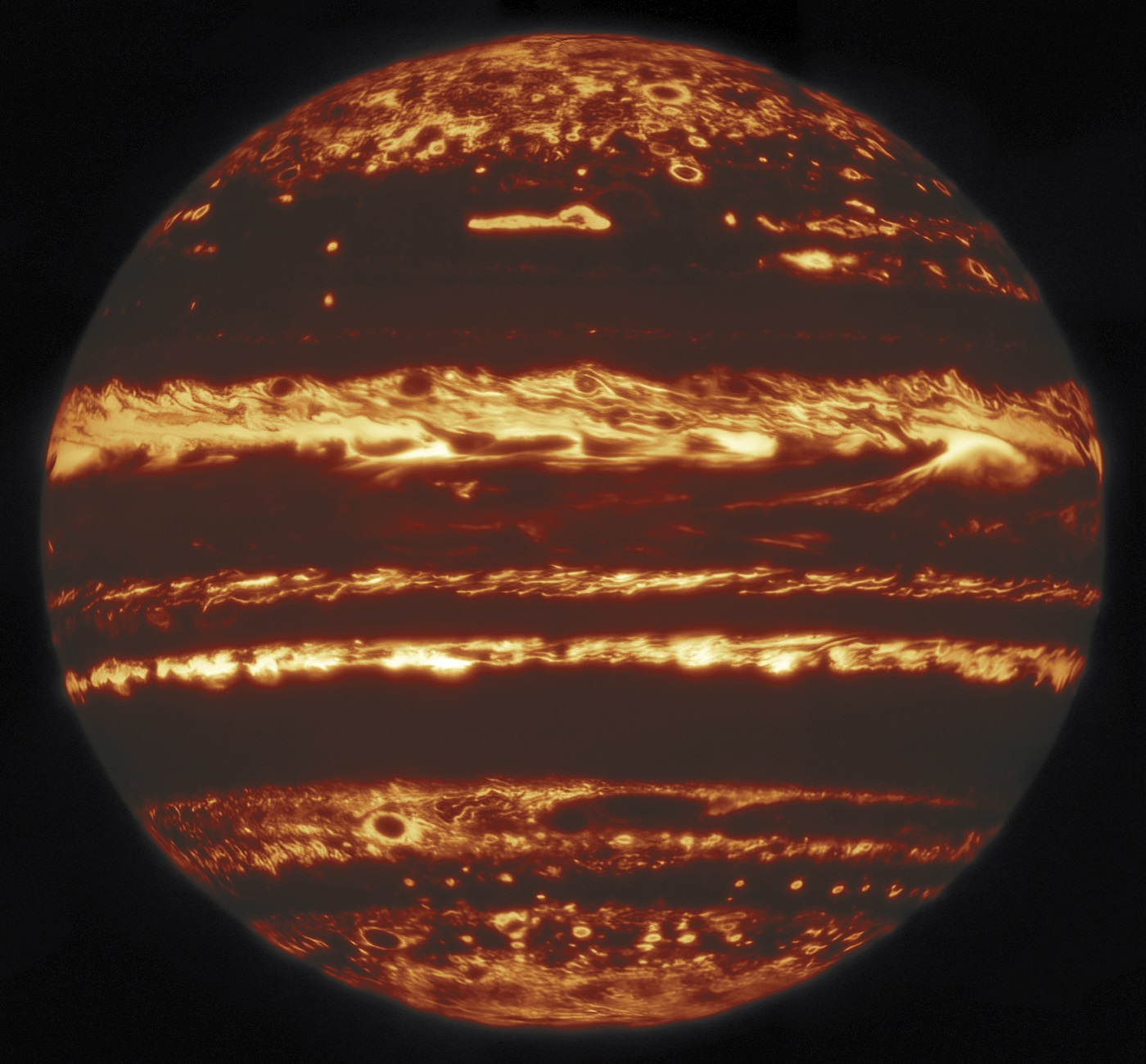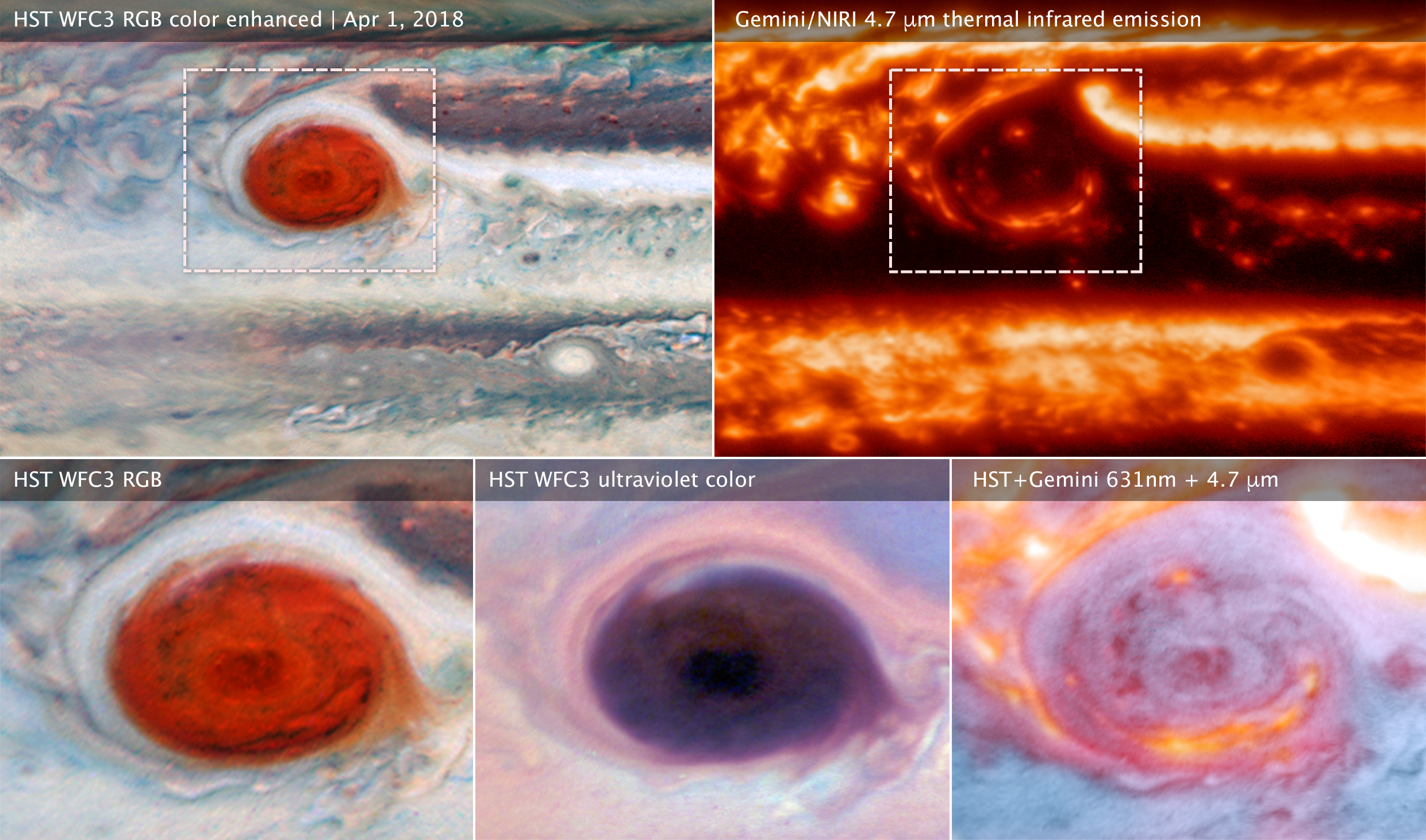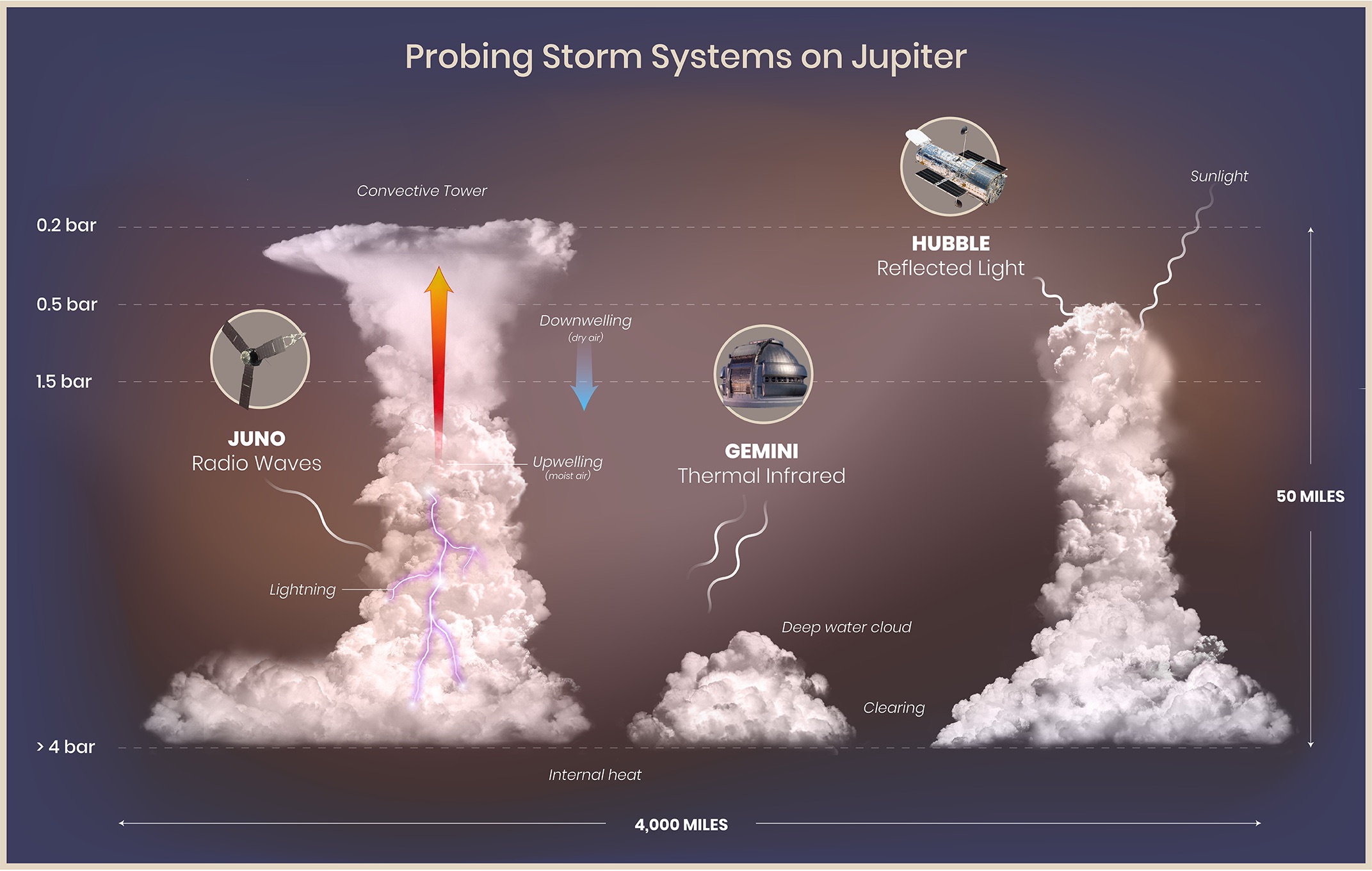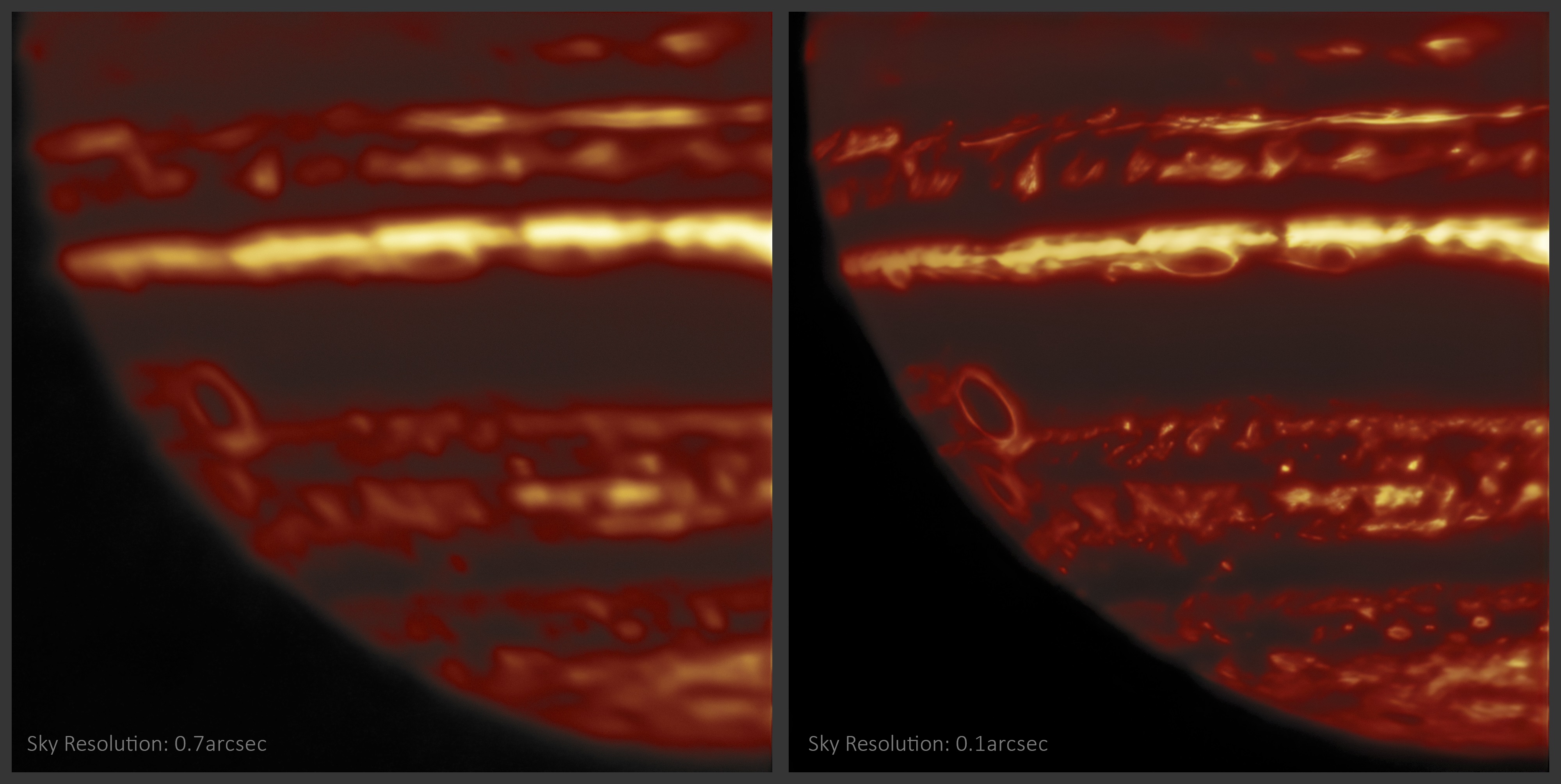Scientists get their best-ever look at Jupiter's atmosphere and storms
It's always dark and stormy on Jupiter — and now, scientists have gotten their most detailed view of the wild storms that swirl through the gas giant's atmosphere.
Those observations are thanks to a very powerful partnership that stretches from Earth's surface to Jupiter itself. Start with NASA's Juno probe, which has been orbiting Jupiter since 2016, then recruit NASA's Hubble Space Telescope, which has checked in on the solar system's largest planet throughout its three decades of operation. Finally, add in the Gemini Observatory in Hawaii to support the observations from Earth.
"Because we now routinely have these high-resolution views from a couple of different observatories and wavelengths, we are learning so much more about Jupiter's weather," Amy Simon, an astronomer at NASA's Goddard Space Flight Center in Maryland who focuses on planetary atmospheres and took part in the new research, said in a NASA statement. "This is our equivalent of a weather satellite. We can finally start looking at weather cycles."
Related: In photos: Juno's amazing views of Jupiter

And there's plenty of weather on Jupiter to look at. Although the Great Red Spot is the most famous storm on the giant world, all of the gas giant's storms are impressive, with clouds stretching five times higher than Earth's equivalent and lightning three times more powerful than the strongest bolts on Earth.
Every 53 days, Juno skims over Jupiter's cloud tops in a close approach called a perijove, gathering data all the while. Among the spacecraft's instruments is a microwave radiometer, which is tuned to identify lightning strikes and study what ammonia and water vapor are doing in the gas giant's atmosphere.
The scientists behind the new research arranged to target Hubble and Gemini to study Jupiter in coordination with Juno's schedule. So while Juno studies a swath of the gas giant as it passes overhead, Hubble and Gemini study the bigger picture of atmospheric activity on Jupiter.
Get the Space.com Newsletter
Breaking space news, the latest updates on rocket launches, skywatching events and more!
Specifically, Hubble images the planet in visible light and lets scientists measure the height of convective towers. Meanwhile, Gemini looks in infrared light to peer through gaps in high-level clouds, where scientists suspect drier air is sinking, to the water clouds hidden deep below.

If that doesn't sound sufficiently impressive, consider the detail that Gemini was able to identify in its infrared observations, spotting features on Jupiter 300 miles (500 kilometers) across. "At this resolution, the telescope could resolve the two headlights of a car in Miami, seen from New York City," Andrew Stephens, a Gemini Observatory astronomer who led the observations, said in an observatory statement.
Juno has made 26 flybys of the gas giant to date, which means the trio of observatories have built up quite a data set about Jupiter's atmosphere, and scientists have only released the most preliminary findings to date.
But those findings already suggested that lightning was most common in a feature that scientists call a filamentary cyclone. "These cyclonic vortices could be internal energy smokestacks, helping release internal energy through convection," Michael Wong, an astronomer at the University of California, Berkeley, and lead author on the new research, said in the NASA statement.
That convection pulls layers of Jupiter's atmosphere up and down depending on factors like temperature and humidity. Earth's atmosphere does this as well, but not in exactly the same way.

"Scientists track lightning because it is a marker of convection, the turbulent mixing process that transports Jupiter's internal heat up to the visible cloud tops," Wong said in the Gemini statement. "Ongoing studies of lightning sources will help us understand how convection on Jupiter is different from or similar to convection in the Earth's atmosphere."
In the meantime, the researchers behind the observatory collaboration have already answered one longstanding question about Jupiter's atmosphere, specifically the Great Red Spot storm that has roiled for centuries. Astronomers had long wondered whether transient seemingly dark spots in the storm are caused by a different compound in the atmosphere or by gaps in the cloud cover.
And combining the data gathered in close succession by Hubble and Gemini allowed scientists to answer that question: because the dark spots shine brightly in infrared, as deep water clouds do, they seem to represent gaps in upper clouds.
"It's kind of like a jack-o-lantern," Wong said. "You see bright infrared light coming from cloud-free areas, but where there are clouds, it's really dark in the infrared."

The scientists are also using the data set to analyze zonal winds, atmospheric waves, convective storms, cyclonic vortices and polar atmospheric phenomena like hazes — and, of course, they anticipate that plenty of other scientific puzzles will benefit from the observations as well.
Juno's next perijove takes place in early June; the mission is scheduled to continue at least through next summer.
The research is described in a paper published April 1 in The Astrophysical Journal Supplement Series.
- Incredible NASA photos show Jupiter's marbled atmosphere
- This gorgeous picture of Jupiter from NASA is just what we need right now
- Juno snaps dazzling images as it prepares to jump Jupiter's shadow
Email Meghan Bartels at mbartels@space.com or follow her @meghanbartels. Follow us on Twitter @Spacedotcom and on Facebook.
OFFER: Save 45% on 'All About Space' 'How it Works' and 'All About History'!
For a limited time, you can take out a digital subscription to any of our best-selling science magazines for just $2.38 per month, or 45% off the standard price for the first three months.
Join our Space Forums to keep talking space on the latest missions, night sky and more! And if you have a news tip, correction or comment, let us know at: community@space.com.

Meghan is a senior writer at Space.com and has more than five years' experience as a science journalist based in New York City. She joined Space.com in July 2018, with previous writing published in outlets including Newsweek and Audubon. Meghan earned an MA in science journalism from New York University and a BA in classics from Georgetown University, and in her free time she enjoys reading and visiting museums. Follow her on Twitter at @meghanbartels.
-
rod Jupiter in the early morning sky is putting on quite a show for telescope viewers. It is now larger than 42" angular size with many cloud bands visible at higher power views (> 70x) and with good planet filters can be very pleasing to observe.Reply -
Lovethrust Reply
Yep even my little 100mm scope is giving excellent views!rod said:Jupiter in the early morning sky is putting on quite a show for telescope viewers. It is now larger than 42" angular size with many cloud bands visible at higher power views (> 70x) and with good planet filters can be very pleasing to observe.










